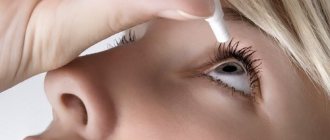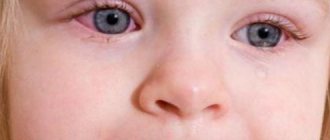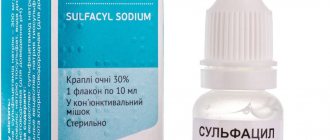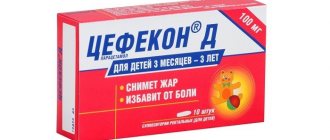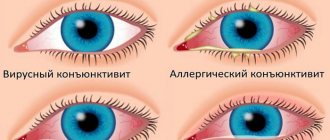All ophthalmic preparations are manufactured according to certain requirements. Eye drops for children must meet a number of conditions - be sterile, free of impurities and toxic substances, and have a concentration that meets the standards.
Only a doctor who has examined the child and taken a thorough history can prescribe effective eye drops for children.
Also find out how to treat conjunctivitis in newborns with drops from an article by an ophthalmologist.
A detailed description by a specialist of how to put drops into the eyes of newborns safely and without any problems for mother and child.
Eye drops containing antibiotics
Most antibacterial eye drops are prohibited for use in the fight against infectious processes occurring in children. When antibacterial drops are used incorrectly and inappropriately, microorganisms tend to mutate, which, against the background of suppression of the eye’s own microflora, allows new strains to arise, and this leads to the development of a chronic, sluggish disease.
The mistake that parents make when purchasing new, and therefore effective, eye drops, which are recommended by friends (pharmacists, advertising), is the occurrence of superinfection, chronicity of the process, the occurrence of fungal infections that cannot be treated adequately and lead to the death of the organ.
Allergic reactions can also be triggered by the use of fairly strong drugs in excess doses. Despite local use, side effects of the drugs are also an undesirable effect.
Before using even absolutely safe eye drops, you should be examined by a doctor.
Recommended antibacterial eye drops for children
Sulfacyl sodium eye drops (Albucid)
Used for inflammatory diseases caused by staphylococcal, streptococcal, gonococcal and chlamydial flora in children.
Albucid is instilled into the eyes of a child for bacterial conjunctivitis, as well as for bacterial and traumatic keratitis. This remedy can be used from birth.
If you drop drops into your eyes, a burning sensation occurs almost immediately, which goes away quite quickly.
The instillation regimen may vary. In severe cases, albucid is instilled frequently, almost hourly, or once every 2 hours for 10 days.
It is recommended to change Albucid to another antibacterial agent if the patient’s condition begins to worsen.
Tobrex
Eye drops, the antibacterial effect of which is possible due to the main component - tobramycin (macrolide).
Tobrex eye drops are used for newborns from the first hours, preventing gonococcal infection. In this case, 1 drop of the drug is dripped once into each eye.
Recommended regimen for the treatment of purulent conjunctivitis, keratitis and blepharitis: drop a drop into the eyes every 2 hours for 7 days.
The frequency of administration, as well as the replacement of the drug, is controlled by an ophthalmologist.
Levomycetin – 0.25% eye drops
Levomycetin drops are a successful combination that combines both chloramphenicol and orthoboric acid.
Its use is recommended in the treatment of bacterial conjunctivitis, keratitis, dacryocystitis, and barley.
The instructions for use of the drug indicate that these drops can be instilled into a child only when he reaches the age of 2 years.
In newborns, chloramphenicol can be used only in cases where there are no alternative options, when this is the only chance to preserve the organ of vision and visual functions.
Levomycetin is instilled drop by drop into the inflamed eye every 3 - 4 hours for 14 days. Peculiarities of administration should be discussed with an ophthalmologist in order to monitor the occurrence of side effects.
Levomycetin has side effects, manifested by hematopoietic disorders (leukopenia, thrombocytopenia, aplastic anemia), allergic reactions. In case of overdose, impaired renal function is noted.
Levomycetin is not a harmless drug, do not start using it yourself. Before use, consult an ophthalmologist.
Tsiprolet
A drug containing the fluoroquinolone ciprofloxacin.
It is mainly used in children for advanced inflammatory processes of a bacterial nature or for severe infections. Tsiprolet is allowed to be used by children over 1 year of age. It is necessary to adhere to the application regimen: drop into the affected eye up to 6 times a day for 10 days.
Tsiprolet should be used after consultation with an ophthalmologist.
Early cessation of use leads to the formation of special bacteria resistant to drugs of this series. As a result, the process becomes chronic.
Tsiprolet is not used for diseases of viral etiology that are not complicated by a bacterial component, since the condition may worsen due to inhibition of the eye’s own microflora and the addition of an infection.
Tsiprolet contains components to which allergic reactions may develop.
Vitabact
A drug that has an antiseptic effect, allowing it to be considered both as antiviral drops and as a weak antibacterial and antifungal agent.
Due to its ability to influence bacterial, viral and fungal nature, Vitabact should be used in severe cases in combination with powerful antibacterial drugs.
Remember that the drug has a weak antimicrobial effect compared to antibacterial drugs, so its use as the main remedy for purulent processes may have undesirable consequences.
Vitabact is used drop by drop every 2 hours for 14 days under the supervision of an ophthalmologist.
Vitabact has a number of side effects, mainly due to allergies to the components. Before instillation, Vitabact should be slightly warmed in your hand so that the bottle and its contents reach body temperature.
How to wash babies' eyes
Caring for a baby's eyes is necessary from the first days of his life. Mom should learn this while still in the maternity hospital. Treatment of the visual organs has the following goals:
- protection against various infections that could be acquired during the passage of the fetus through the birth canal;
- elimination of the “dry eye” effect in an infant;
- cleansing tear ducts from secretions;
- prevention of inflammation and redness.
Even if the healthy eyes of a newborn need careful care, then in the presence of symptoms of various diseases, instillation of the child’s visual organs should be regular.
Rinsing and treating the affected eye is carried out in the morning and evening. If necessary, the procedure can be performed more often; the number of washes is determined by the doctor depending on the cause of suppuration and the severity of the disease.
Before the procedure, you need to prepare eye drops, cotton wool or cotton pads, and gauze. The eye treatment process includes the following steps:
- Place the baby on his back on the changing table. The baby must be awake, otherwise the procedure may frighten him.
- To protect the eye, apply a cotton pad to the baby's lower eyelid.
- Gently open the child's eyelids, lifting the upper eyelid.
- With your free hand, place 1-2 drops into the corners of the baby's eyes.
- Close the eye and lightly run your finger over the eyelid for maximum absorption of the product.
- Remove excess drops with a clean cotton pad or piece of gauze, making sure that no lint remains in the eye.
To enhance the therapeutic effect after instillation, you can massage the lacrimal sac. If pus is released from the eye, you need to carefully remove it with gauze or a cotton pad.
Anti-allergy eye drops for children
The use of antiallergic eye drops is only a symptomatic treatment and can only be used as an adjuvant therapy.
Adult eye drops for allergies are practically not used for children. Most drops contain substances that can harm the child's body. For example, drops containing steroidal and non-steroidal anti-inflammatory substances are often used in adults.
Children are recommended to use them only after reaching the age of 7 years. This is explained by the high probability of developing adverse reactions and the lack of safe dosages designed for the baby’s body.
Vasoconstrictor drops reduce swelling by narrowing blood vessels. Nasal drops used for a runny nose also work. Indicated for use by children over 3 years of age, since the drops are absorbed quite well and can cause narrowing of larger vessels, which leads to the development of collapsed states and fainting.
Types of drugs and classification
All drops recommended when putting on contact lenses have one goal - to create an artificial film on the surface of the cornea. Despite this, there are several classifications.
Table 1. Classification of drops for contact lenses.
| View | What are they made of? | What are they used for? |
| Moisturizing liquids | Salt composition with preservatives that act as an antibacterial agent. Glycerin, monosodium glutamate, or povidone are added to aid hydration. | The components of the drops are distributed throughout the hemisphere of the cornea in the form of an imperceptible film that remains on the eye for a long time. Thanks to its antibacterial effect, it cleanses the eye and relieves suppuration. |
| Lubricants | Contains water-soluble polymers. These are hydroxypropyl methyl cellulose, glycerin or carboxymethyl cellulose. | Allows you to create a protective film on the surface of the eye. The substances in the drops also help get rid of the natural protein cells that appear on the lenses. |
| Artificial tear preparations | Components similar in composition to natural human tears. | Eliminate the feeling of “dry eye”, neutralize discomfort from wearing lenses, help with tear fluid deficiency. Additionally, the cornea is disinfected. |
Eye drops Artificial tears
Preparations are also produced that simultaneously have moisturizing and lubricating properties. Another classification divides eye drops according to the reasons that caused discomfort to the wearer of the lenses.
- Antiallergic. Used by patients with sensitive eyes who often experience allergic reactions to external irritants.
- Vasoconstrictors. Allows you to quickly eliminate redness caused by the expansion of microvessels. Do not use if discomfort occurs due to infection in the eye. You should not use them for a long period, as addiction is possible.
- Anti-inflammatory. Prescribed if prolonged irritation with contact lenses has led to inflammation caused by infection in the irritated eye. They can be used both to correct the situation and to prevent the occurrence of inflammatory processes.
Types of eye drops for inflammation
At their core, the eye drops offered for owners of corrective lenses are a type of standard salt-based solution used during their processing and storage. The only difference is that the medications are additionally supplied with moisturizing or lubricating compounds.
With moisturizing drops, the process of wearing lenses will be comfortable and painless
Eye drops for allergies, the use of which is permitted in childhood
1. Allergodil is a drug that allows you to cope with conjunctivitis of an allergic nature in children 4 years of age and older. Its action is aimed at blocking H-1 histamine receptors. The recommended dosage regimen is to use the drug drop by drop every 3 to 4 hours. The duration of use is controlled by an ophthalmologist.
2. Okumetil is a combined drug with antiseptic and antiallergic properties. Use is permitted for children two years of age and older. Instill drops every 3 - 4 hours.
If you suspect that allergic manifestations are associated with the use of eye drops, then drop each of the drugs into the eyes at intervals of 30 minutes. The appearance of increasing watery eyes, redness, and itching indicates allergic manifestations. Stop using the drops. To change the drug, contact the doctor who prescribed the treatment.
Remember that before using antiallergic drops, you should consult an ophthalmologist and allergist for a full course of therapy to stabilize the condition and achieve stable remission.
Artificial tears with hypromellose
What it is. Hypromellose is a viscous polymer substance that promotes the formation of a protective tear film, prevents drying of the eye mucosa and alleviates discomfort. Sometimes another polymer is added to the drops - dextran 70.
The price of drops with hypromellose depends on its quantity: the more active ingredient, the better the softening properties of the drops and the more expensive the drug. The price of drops with hypromellose and dextran depends solely on the pharmaceutical company: both drugs are sold in 15 ml bottles and do not differ in composition.
Evidence of effectiveness. Drops based on hypromellose and with dextran are on the list of products recommended for the treatment of dry eyes in the international Uptodate directory. These drops have long been used in ophthalmic practice and have been well studied.
For example, hypromellose drops are known to be suitable for moisturizing hard contact lenses, which are made according to individual prescriptions for patients with serious vision problems such as keratoconus.
Nuances. For the medicine to work, it is enough to drop 1-2 drops into one eye. They can be used 4-8 times a day, and if necessary, even every hour. You can insert soft contact lenses only 30 minutes after putting the drops into your eyes.
For some people, drops with hypromellose cause eye irritation - in this situation, the product must be replaced with an artificial tear of a different composition. The drug is contraindicated in pregnant women. Before buying drops for a child or teenager, consult an ophthalmologist.
